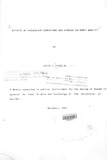| dc.contributor.author | Kasolia, DJ | |
| dc.date.accessioned | 2013-05-11T08:38:39Z | |
| dc.date.available | 2013-05-11T08:38:39Z | |
| dc.date.issued | 1991-12 | |
| dc.identifier.citation | Kasolia, D.J(1991).Effects of processing conditions and storage on honey quality | en |
| dc.identifier.uri | http://erepository.uonbi.ac.ke:8080/xmlui/handle/123456789/21780 | |
| dc.description | Msc - Thesis | en |
| dc.description.abstract | Fresh Kenya crude honey was collected from two districts and
analyzed for their physico-chemical properties before and after
heat processing at each of the temperatures for 20, 25 and 30
minutes 50° , 55° The physico-chemical
properties analyzed included residual diastase (amylase)
activity, hydroxmethylfurfural (HMF) content, colour and rate of
crystallization. Processed honeys wet~e also analyzed for the
same during six months of storage room temperature (18±4°C) ,
Significant differences at 5% level were found in crystallization
rate between all processing temperatures used. Levels of HMF
differed significantly (P=0.05) between unheated and heated
samples and also between samples heated at 45°C and those
processed at other temperatures. Samples heated at 50GC also
differed significantly (P=0.05) in HMF content with those heated
Generally, increased temperatures resulted in
increased HMF production. The co lour- as measured in terms of
optical density at 440 nm showed significant differences (p=0.05)
between unheated and heated samples, while heated sampled did not
differ significantly among themselves. However, there was a
positive correlation between increased processing temperature and
increased optical density in all samples studied. No significant
differences (P=0.05) in diastase activity were found among all
honey samples studied, although there were noticeable decreases
in diastase residual activity with increased processing
temperatures.
Increase in storage temperature and/or time resulted in increased
rates of HMF production with high temperatures (28°C and 3S-C)
showing HMF values above those recommended for table honey (40
ppm) after six months of storage. The rate of diastase
inactivation increased with increased storage temperature and/or
time. Within four months' storage at 3SoC, the residual diastase
activity had been lowered to below number of 8, the minimum
recommended for' table honey. The optical density (for colour)
increased with increased storage time and/or temperature. High
storage temperatures (28- and 3S-C) showed significantly higher
(p=o.OS) optical density and visual colour than those at lower
temperatures (22° and 18 - 4°C • Increased storage temperature
and/or' time resulted in decreased rate of crystallization with
most samples stored at 28° and 3SoC showing no crystallization at
all after six months of storage.
Processing at 55°C for 25-30 minutes and storage at 25-26°C could
be recommended as the most appropriate for honey processing and
storage. | en |
| dc.description.sponsorship | University of Nairobi | en |
| dc.language.iso | en | en |
| dc.subject | Processing conditions | en |
| dc.subject | Storage | en |
| dc.subject | Honey quality | en |
| dc.title | Effects of processing conditions and storage on honey quality | en |
| dc.type | Thesis | en |
| local.publisher | Department of Food Science, Nutrition and Technology, University of Nairobi | en |

